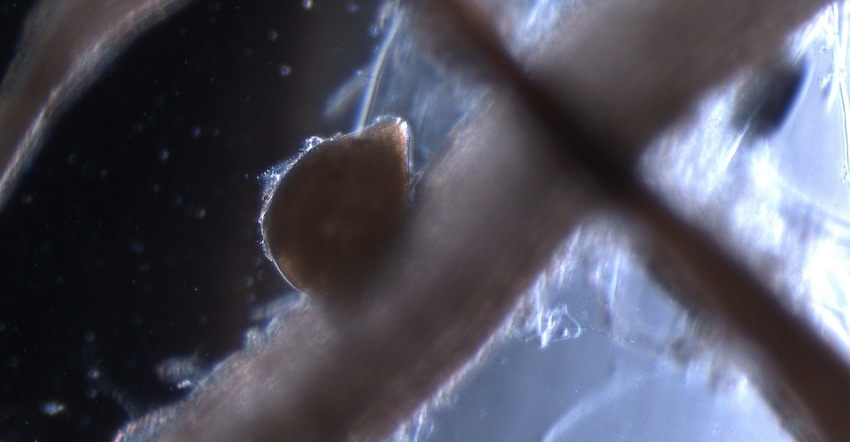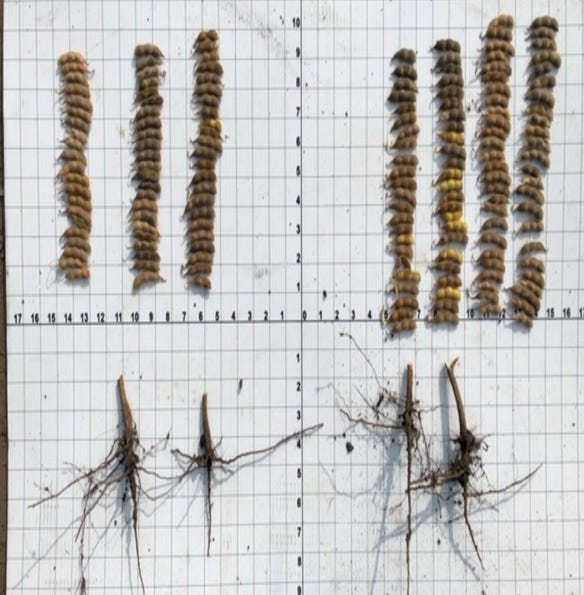
Adverse weather conditions are a detriment to producers but a boon for researchers, who get a chance to see how well crop protection products perform when facing a challenge.
That was true at the BASF soybean demonstration plots near Lawrence where researchers got a chance to see how well seed treatments worked to protect their plants from soybean cyst nematodes and sudden death syndrome. They shared their results at a September field day.
“We had quite a bit of rain in the spring and timely rains through the summer,” according to Troy Bauer, BASF technical field representative. “We were seeing sudden death syndrome raising its ugly head on quite a few acres in this region.”
The BASF plots, however, appear healthy as harvest approaches.
The two pests — SCN and SDS — have a high overlap on many acres in the river valleys of northeast Kansas. SDS likes cooler, wet conditions while the nematodes do more damage in hot, dry weather.
Having a product that protects the crop from both pests is an advantage because growers never know what conditions they will face in a given year.
“The nematodes start by infecting the roots of the plant,” Bauer says. “The juveniles burrow in and establish a feeding site on the roots. After reproduction, the females appear as a cyst full of eggs on the roots. When that cyst ruptures it releases more juveniles that burrow in and repeat the process. One cyst nematode can become a million in a single year.”
He says controlling the nematodes requires an integrated approach that includes crop rotation, planting varieties with a strong genetic resistance to nematodes and using a seed treatment such as ILEVO that is effective at controlling nematodes.
ILEVO works at all lifecycle states, reducing reproduction by 55% and reducing hatching by 96%. It reduces root penetration by 50% and motility by 82%.
That same seed treatment is effective at controlling SDS, a fungal disease caused by fusarium virguliforme, which lives in the soil or in field residue.
SDS starts below ground as a root rot. In cool, wet conditions — like much of northeast Kansas had this summer — the rainfall flushes a toxin produced by the fungus through the plant’s vascular system to the upper soybean canopy where it causes necrosis.
“One problem with SDS is that it reproduces on corn, but the corn doesn’t show any symptoms. That is especially troublesome in regions where there is a predominant corn-soybean rotation,” Bauer says. “This makes it really important to plant varieties with more resistance and to use seed treatments for protection.”

GOOD RESPONSE: The left side had a base fungicide and insecticide, while the right side was a base fungicide and insecticide with ILEVO at the sudden death syndrome and soybean cyst nematode rate. BASF says this is a nice response in terms of a healthier root system and more pods of beans.

ILEVO has proven to be a reliable treatment that provides a good return on investment, he says.
Another effective seed treatment is Vault IP Plus, which combines a superior rhizobial strain and U.S. EPA registered, dual-strain biofungicides which promote more vigorous roots and increased nutrient uptake.
In addition, it is the lowest application volume available in the market. The rhizobia in Vault were selected for their ability to fix the maximum amount of nitrogen in soybeans allowing soybean growers to continue to raise their soybean yield potential.
On the seed side, technical representative Jeff Mueller says BASF is introducing its Xitavo-brand soybean seed with the Enlist E3 technology. The Xitavo brand is owned by MS Technologies and distributed exclusively by BASF.
Xitavo seed have tolerance to 2,4-D choline herbicides as well as glyphosate and glufosinate herbicides.
BASF also continues to expand its Credenz line of soybean varieties, which have the Liberty Link trait with tolerance to Liberty herbicide. It has also introduced the LLGT27 program, which allows the use of Liberty as well as glyphosate and glufosinate herbicides.
“The goal is to start with a clean field at planting and keep it clean during the growing season,” Mueller says. “The newer varieties give you more options for rotating herbicides and helping control the development of resistant weeds.”
About the Author(s)
You May Also Like






